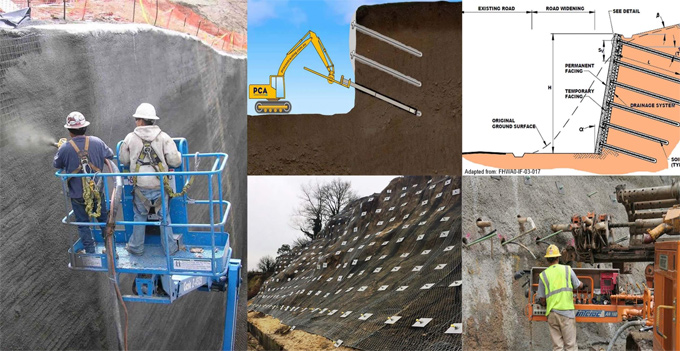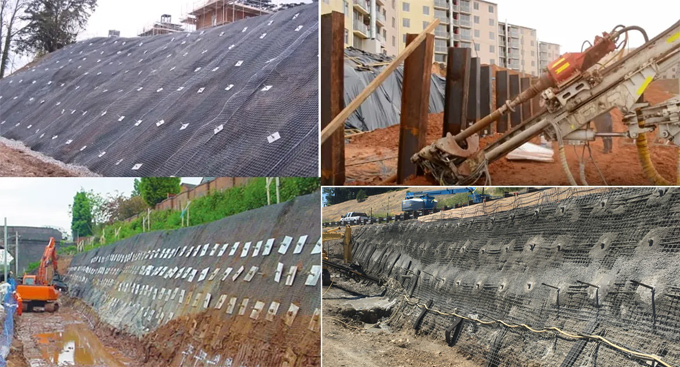
Soil Nailing Technique: Understanding about the Process, Methods and Benefits

Soil nailing is the ground reinforcement technique in which steel bars or steel pipes have been inserted into the ground which helps to get a supportive structure. In this technique, the nails have been installed in a pattern which helps to reinforce the existing soil mass and helps to stabilise the slopes. In addition, the soil nailing technique also helps to prevent landslides as well as helps to support excavations.

In the soil nailing procedure, the soil nails have been installed at a specific depth and angle which helps to improve the shear strength of the soil as well as increase the ability of the soil to resist external forces.
Applications of soil nailing
The soil nailing procedures have various geotechnical applications, which are as follows:
➢ The soil nailing is appropriate for stabilizing slopes in the mountain areas thus helping to prevent landslides or erosion.
➢ The soil nail walls have been also used in areas with unstable soil or deep trenches to support excavations.
➢ The soil nail walls have been also used for stabilizing the entrances to tunnels thus helping to prevent rock or soil mass failure.
➢ Soil nailing procedure also helps to provide lateral support in the deep excavation projects which prevents shifts or cave-ins in the soil mass.
➢ The stability to embankments has been also offered by the soil nail walls for supporting bridges which helps to prevent settlement and failure.
Benefits of Soil Nailing
There are numerous effectiveness of the soil nailing procedure, which are:
➢ The soil nailing technique is cost-effective rather than the traditional retaining walls or other types of soil stabilization techniques.
➢ There is less excavation and surface disturbance in the soil nailing technique rather than the traditional retaining walls which is ideal for the areas with little space or urban environment.
➢ The soil nailing procedure can be applied to a wide range of soil conditions as well as to various types of soil gradients.
➢ The soil nail walls have been also used as the retrofitting solutions for those existing structure which faces slope instability.
➢ The installation procedure of the soil nail walls is also fast as compared to the other types of traditional retaining walls which helps to minimize the overall time period of the construction project.
Learn about the soil nailing techniques and procedures
The soil nailing technique has been employed for increasing the stability of the soil, speciality in excavations, slopes or retaining walls. The construction procedure of the soil nail walls has followed several steps, which include:
➢ In the soil nailing technique, the soil has been strengthened with the help of the slender reinforcing bars which are known as nails.
➢ These reinforcing bars have been inserted into the pre-drilled holes.
➢ The soil nails have been installed at the inclination of 10 to 20 degrees from the vertical.
➢ Concrete, shotcrete and other types of grouting materials have been applied to the excavation face during the progression of the excavation procedure which helps to reinforce the steel or nails.
➢ The type of soil, depth and spacing of the nail, and other factors influence the success of the soil nailing techniques.
➢ Proper monitoring is necessary during the construction procedure which helps to ensure the optimal performance as well as long-term stability of the reinforced soil structure.

The design consideration of the soil nail walls
The design considerations that need to be followed while designing the soil nail walls are as follows:
The slope gradient
The slope should range from 1:0.2 to 1:0.5 along with the slope angle which should not exceed 1:0.1 to achieve optimal stability. The slope’s height, the soil type and the rock strata guide the design of the soil nail walls.
The spacing of the soil nails
The spacing among the soil nails is another important factor which helps to ensure the structural integrity and proper distribution of the load. Poper spacing among the soil nails ensures the work accuracy of the soil nail for stabilizing the soil mass and preventing failure. The lateral spacing should range from 1.2m to 2.0m and it is reduced to less than 1.2m in soft soils for greater reinforcement.
The soil nail arrangement’s shape
The soil nail arrangement depends upon the constitution of the site. The most common configuration of the soil nail arrangement is the rectangular, square and triangular arrangement.
The tilt angle of the soil nail
The tilt angle should be between 10° and 20°, this helps to ensure the slurry used in the grouting flows from the drill hole to the soil.
The soil nail’s length
The soil nail’s length should be 0.5 to 1.2 times the height of the wall. The length of the soil nail can be adjusted on the basis of the soil types, and rock conditions, for example, soft soils require longer nails.
The types of materials
The soil nails have been made of steel or steel pipes. The selection of the material for the soil nails should be based on the load-bearing capacity, soil conditions, and corrosion resistance.
To learn more, watch the following video tutorial.
Video Source: Bridge Construction Training Institute
Geological characteristics
The geological conditions should be assessed before designing the soil nailing walls. This assessment includes the shear strength of the soil, the groundwater level and the potential for the erosion of the soil. This assessment helps to determine the appropriate design for the soil nail and decides if any kind of anti-corrosion measures will be required for the soil nails.


